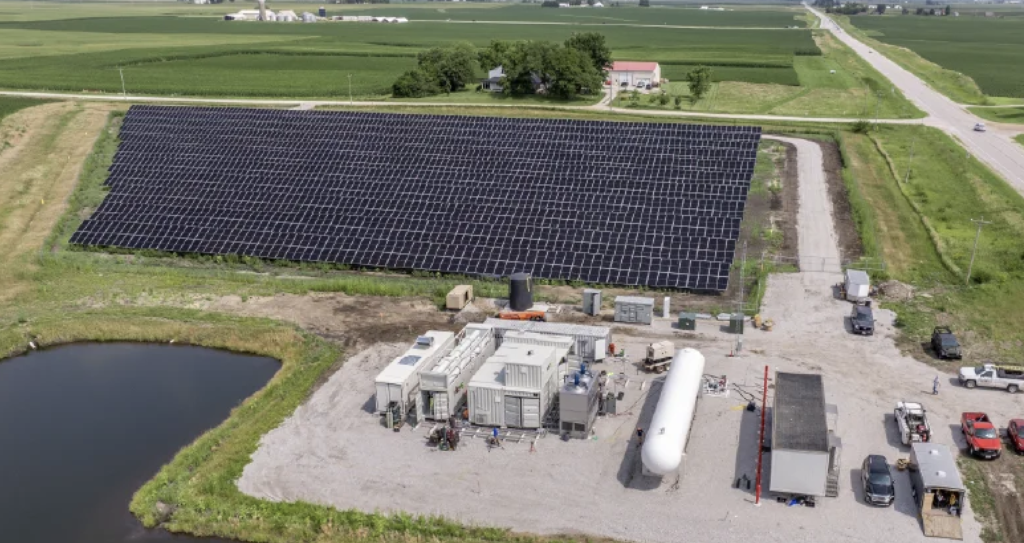
Sign up for daily news updates from CleanTechnica on email. Or follow us on Google News!
File this one under M for more evidence that the energy transition is unstoppable, Trump or no Trump. The latest development comes from Trump-voting Iowa, where two US firms have hatched a green ammonia scheme to help farmers cut their fertilizer costs. It may be too little, too late to save some farmers from the economic ruin fostered by the Trump freeze on federal funds, but perhaps others will survive.
Concerned about the rolling destruction of the US government? Call your representatives in Congress (there’s an app for that).
Green Ammonia Fertilizer To Save Farmers From Trump
Farmers across the country are staring bankruptcy in the face because they paid up front for improvements that were supposed to be covered by awards issued by the US Department of Agriculture, which are now frozen because of Trump. Adding to the hurt, they can’t sell crops to USAID any more because of Trump. Fortunately, a greener future awaits those who can survive the next four years.
The Iowa-based agricultural solutions firm Landus has been working with the Texas green ammonia company TalusAgsto introduce a cost-cutting, localized, modular green ammonia fertilizer production system to farmers in Iowa and beyond. The local angle is significant because it untangles farmers from the global fertilizer market, which has been in upheaval over the past several years partly on account of Russia, according to the USDA.
Trump’s willy-nilly trade wars threaten to make things even worse (pro tip: next time don’t vote for the felon). “Any import tariffs are likely to disrupt fertilizer supply chains,” explains TalusAg founder and CEO Hiro Iwanaga.
“Our partnership with Landus is critical to building supply chain reliability and resilience within the United States,” Iwanaga adds.
Green Ammonia To Decarbonize Biofuel
Aside from helping to stabilize the fertilizer supply chain, the new green ammonia scheme also helps US farmers compete in global markets where government policies motivate the agriculture industry to cut its carbon footprint. Trump can blow the fossil fuel horn all he wants, but US exporters will lose ground if they don’t keep pace with the global decarbonization movement.
In particular, TalusAg and Landus are eyeballing an assist for energy crop farmers in the US. “In addition to creating long-term price stability, green ammonia can immediately reduce the carbon intensity score of biofuel feedstocks by as much as 25%, providing significant value to domestic biofuels producers.” explains Landus President & CEO Matt Carstens.
That’s all well and good, although Trump has given US energy crop farmers a new reason to worry about their future.
Last December the biofuel news organization Ethanol Producer took note of the record-setting pace of US ethanol exports, with Canada — oh, snap! — as the leading destination. “USDA anticipates 2025 ethanol exports to reach $4.2 billion in value, tying the 2023 record value,” Ethanol Producer emphasized.
Of course, that was before Trump took office on January 20. What happens next is up to Trump and the Republican majority in Congress.
Green Ammonia Fertilizer & The Cost Of Green Hydrogen
All else being equal, the bottom line for green ammonia is cost, and that depends on the cost of green hydrogen. Unlike conventional hydrogen sourced from natural gas or coal, green hydrogen is extracted from sustainable resources. That bucket includes biomass, wastewater, and other wastes. Currently, much of the investor activity is focused on electrolysis systems that deploy electricity to squeeze hydrogen gas from water. Add nitrogen from ambient air, and the result is ammonia (chemical symbol NH3) minus the fossil energy baggage.
Ideally the electrolysis systems deploy electricity from renewable resources, and that is where Landus and Talus are focused. Their modular electrolysis system hooks up with an on-site solar array to provide the hydrogen.
If all this sounds expensive, it is. Here in the US, most hydrogen is sourced from natural gas, and it easily beats green hydrogen on cost. However, a new federal tax credit for electrolysis and other lower-carbon hydrogen systems helps to balance out costs. Talus states that its green ammonia can shave 50% off the cost of conventional nitrogen fertilizers.
Of course, Trump could try to freeze the clean hydrogen tax credit. US tax law is notoriously difficult to change, but he could still try.
Until that happens, TalusAg and Landus have already launched plans to send their modular green ammonia system sailing across the Corn Belt and other parts of the US.
A demonstration facility in Boone, Iowa, has been up and running to introduce farmers to the system in action. It produces one ton of green ammonia daily, using solar energy from a dedicated 1-megawatt solar array located at the site.
Next Steps For Green Hydrogen In The US
Meanwhile, the global green hydrogen industry is struggling to gather a consistent head of steam. A quick search of the Intertubes easily picks up news about failed businesses and canceled projects. Nevertheless, it’s just as easy to find news about green hydrogen ventures around the world, with Finland, Germany, and a new partnership between Siemens and the Chinese electrolysis firm Gofu Hydrogen among those making headlines this week. In addition, a growing number of nations around the world are formulating coordinated, hub-style green hydrogen strategies.
Here in the US, the Biden administration hatched a plan to leverage the diverse resources of the nation to establish a new network of hydrogen production, transportation, and storage hubs with $7 billion in seed funding from the 2021 Bipartisan Infrastructure Law. Trump froze those funds, too, putting US exporters at a disadvantage as other nations race to establish clean hydrogen hubs of their own.
“Final tax credit guidelines from the Biden administration reward cleaner hydrogen projects regardless of technology but President Trump’s spending review hangs over energy infrastructure buildout,” Reuters Events noted somewhat gloomily on February 12 (Reuters Events is a part of Reuters Professional, operating independently from Reuters News).
On a somewhat brighter note, the cost of green hydrogen has been dropping, and new research at the US Department of Energy’s Princeton Plasma Physics Laboratory could help hurry things along. Last September, PPPL announced a new collaboration with Princeton University, aimed at developing a new plasma-based electrolysis system to bring down the cost of green ammonia.
Oh, wait. That project was covered by a $3.6 million grant from the National Science Foundation…
If you have any thoughts about that, drop a note in the comment thread and share with your House and Senate representatives, too (the insiders say that phonecalls are the most effective way to make your voice heard in Congress).
Photo: A new solar-powered, modular green ammonia system enables US farmers to cut fertilizer costs, stabilize supply chains, and compete against low-carbon goods in global markets (via businesswire.com).
Chip in a few dollars a month to help support independent cleantech coverage that helps to accelerate the cleantech revolution!
Have a tip for CleanTechnica? Want to advertise? Want to suggest a guest for our CleanTech Talk podcast? Contact us here.
Sign up for our daily newsletter for 15 new cleantech stories a day. Or sign up for our weekly one if daily is too frequent.
CleanTechnica uses affiliate links. See our policy here.
CleanTechnica’s Comment Policy

